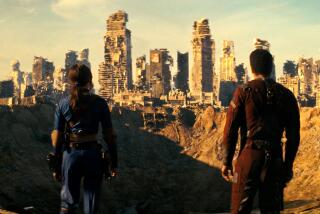Dark Passage : The Darkness, as an Inhabited Place, Has Retreated Into the Past
ANY PLACES on the American landscape have no specific names. Though they exist, they are not thought of as substantial or permanent. They are ephemeral, subject to alteration--or obliteration--by decay or progress.
These places have names but are found on no maps. Yet the places they describe are an inerasable part of the national fabric.
They are the Boondocks, a word that to most of us means a wilderness, a wasteland, a forbidding place where nothing may live but rodents, reptiles and perhaps the enemy.
Another is the Back Forty, a phrase that most of us use to denote the most remote part of our land, however small it may be. Our Back Forty on Mt. Washington is an acre of wild canyon.
Grady Clay, a Kentucky journalist, is at work on what he calls a gazetteer, or encyclopedia, of man-made American generic places--from Abandoned Area to Zoological Garden. Clay thinks we ought to recognize these places, understand their origins and use them to improve our environment.
I am not quite sure what Clay means by âephemeral,â except of course that nothing lasts forever. However, to be called ephemeral, in contrast with nearby developments of an apparently more permanent nature, a place, I suppose, must seem abandoned, run-down or seedy.
Clay sent me a copy of a speech he made recently in Monterey to a group of landscape architects. In it he spoke almost passionately of the future of ephemeral, generic places.
Some of those he mentions are Abandoned Area, Active (or Combat) Zone, the Dark, Holdout and Armpit of the Universe--a name often given to the town next to oneâs own.
I am especially fascinated by Clayâs vision of the Dark as an ephemeral place. He points out what we all know: that in our century there is no Dark. The Dark, as an inhabited place, has retreated into the past. It has been driven out by light.
Clay calls the elimination of the Dark--as a place--the âindoorsingâ of the American people. âOnce upon a time, the Dark was an important part of life. When, in that unlit long gone, you said, âBe sure to get here before dark,â you were talking not schedule, but survival. . . . But now we have surrendered the Dark and all its functions--not all of them illegal or dangerous--to the lighting industries. In much of the eastern United States, thereâs no Dark left. And I hardly find traces of it in California.â
While the Dark is banished, skyscrapers have shadowed streets and created a Twilight Zone. Manhattan Island has become a Twilight Zone, he says. He wonders whether architects, who are always trying to convert the Dark into the Light, ought to explore the possibilities of darkness.
He sees great potential in that most common of generic places--the Abandoned Zone. He argues that within every abandoned place lies the seed of regrowth. âOne manâs abandonment is the next manâs opportunity. Recycling involves more than volunteers smashing old bottles and packaging old newspapers. Itâs a necessary process. Without it, urbanization as we know it is impossible.â
One of Clayâs most appealing ephemeral places, to me, is the Holdout, perhaps because we have so many holdouts here. Holdouts are indeed ephemeral. Hardly a day goes by that we donât miss some old landmark that has pleased our eye for decades. âIt was there only yesterday,â we say to ourselves in wonder and dismay. Angelâs Flight. The Garden of Allah. The Richfield Building.
Perhaps the most visible and famous of our holdouts is the old Janes house on Hollywood Boulevard. Thanks to the stubbornness of the two Janes sisters, this quaint Victorian house has stood throughout the vicissitudes of the boulevard from urbanization to Combat Zone and back again, resisting every overture.
âThey represent now-distant periods in local history,â Clay says of Holdouts. âSome Holdouts melt into the local scenery as unremarkable pieces of the urban fabric, only to strike outsiders with amazement and itchy camera fingers.â
Speaking of Holdouts--whatever happened to Angelâs Flight? Is it is or is it ainât?
More to Read
Sign up for Essential California
The most important California stories and recommendations in your inbox every morning.
You may occasionally receive promotional content from the Los Angeles Times.










